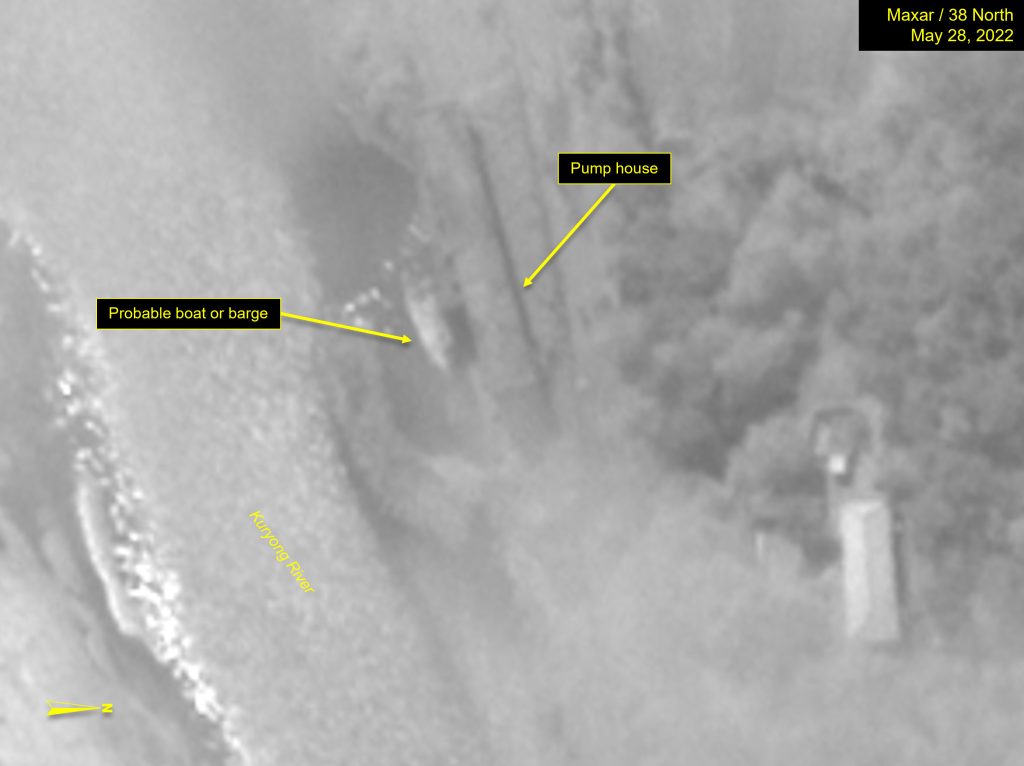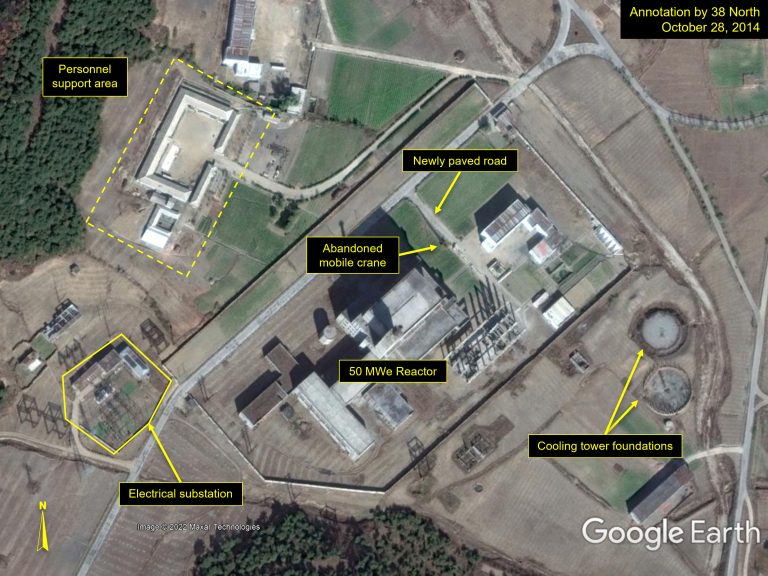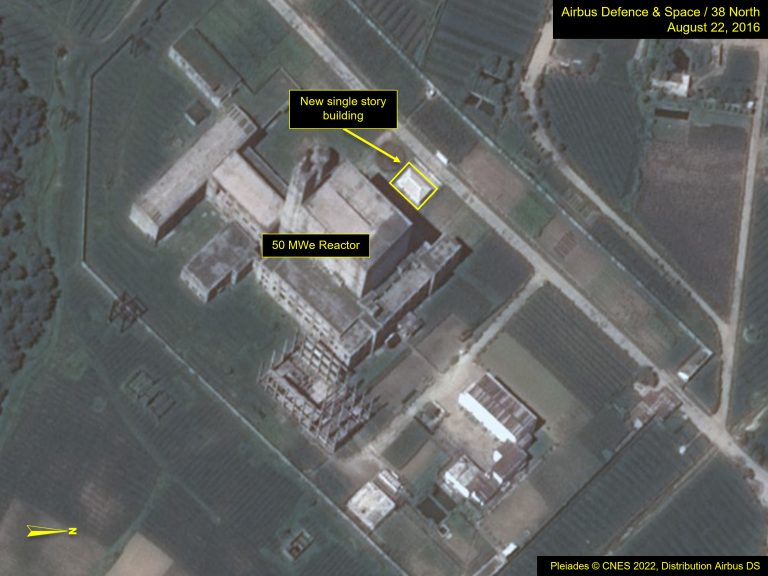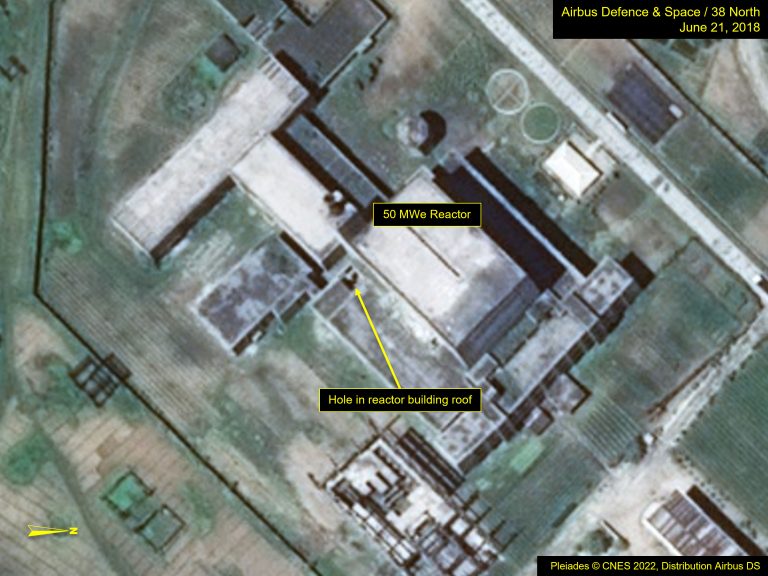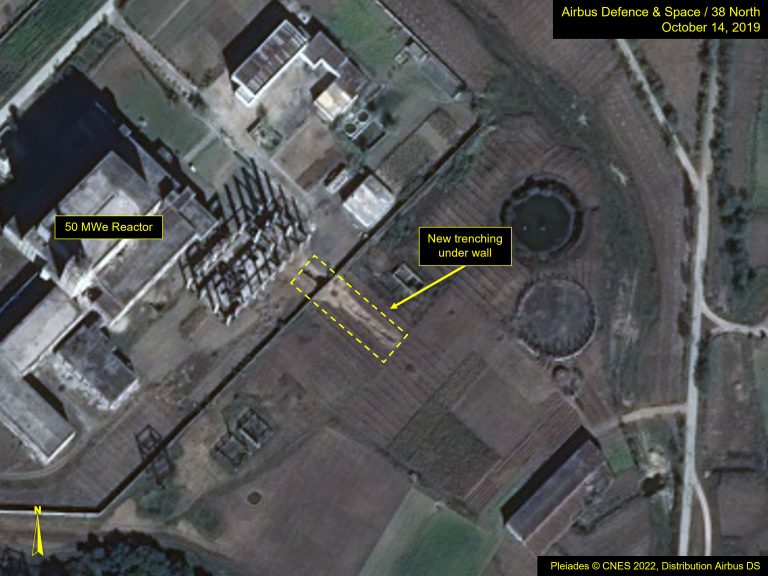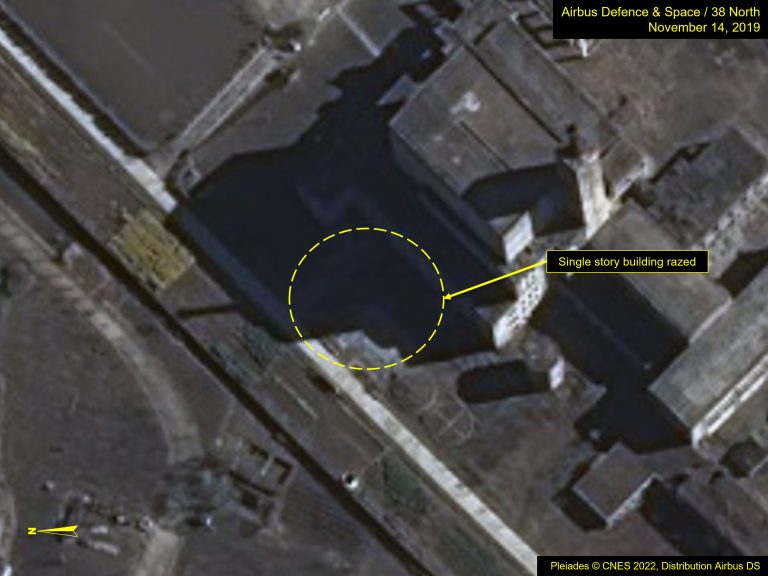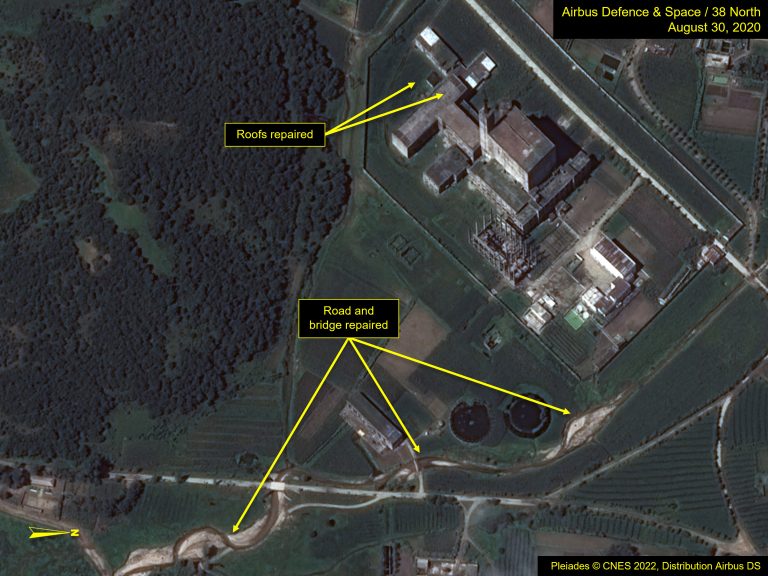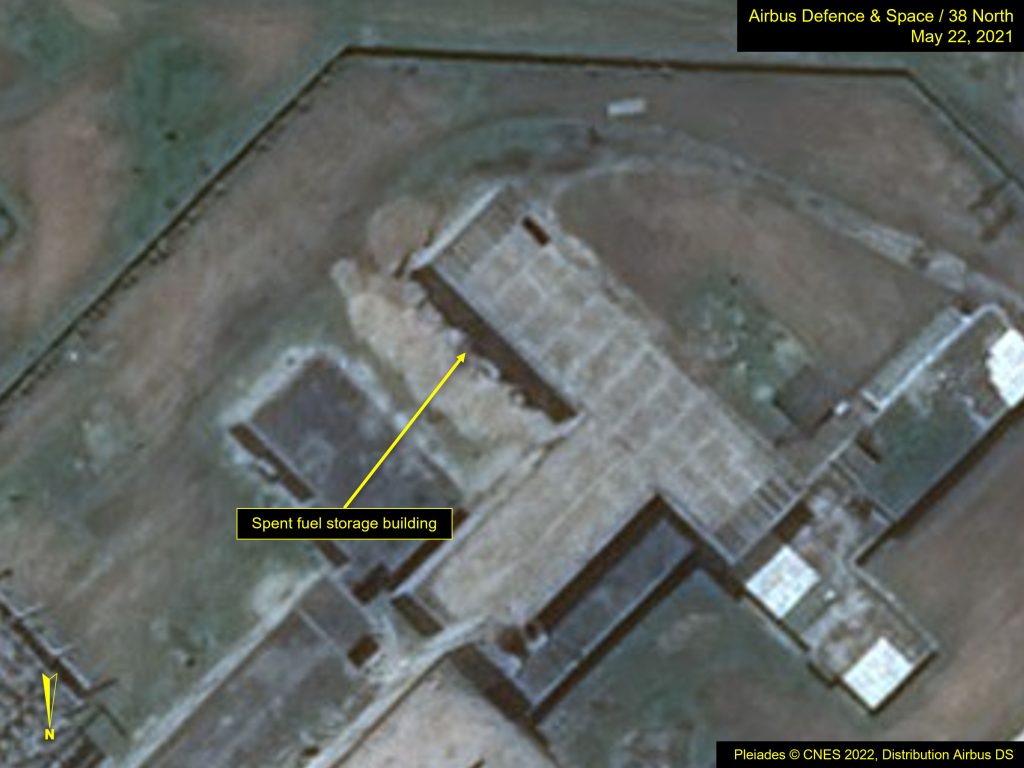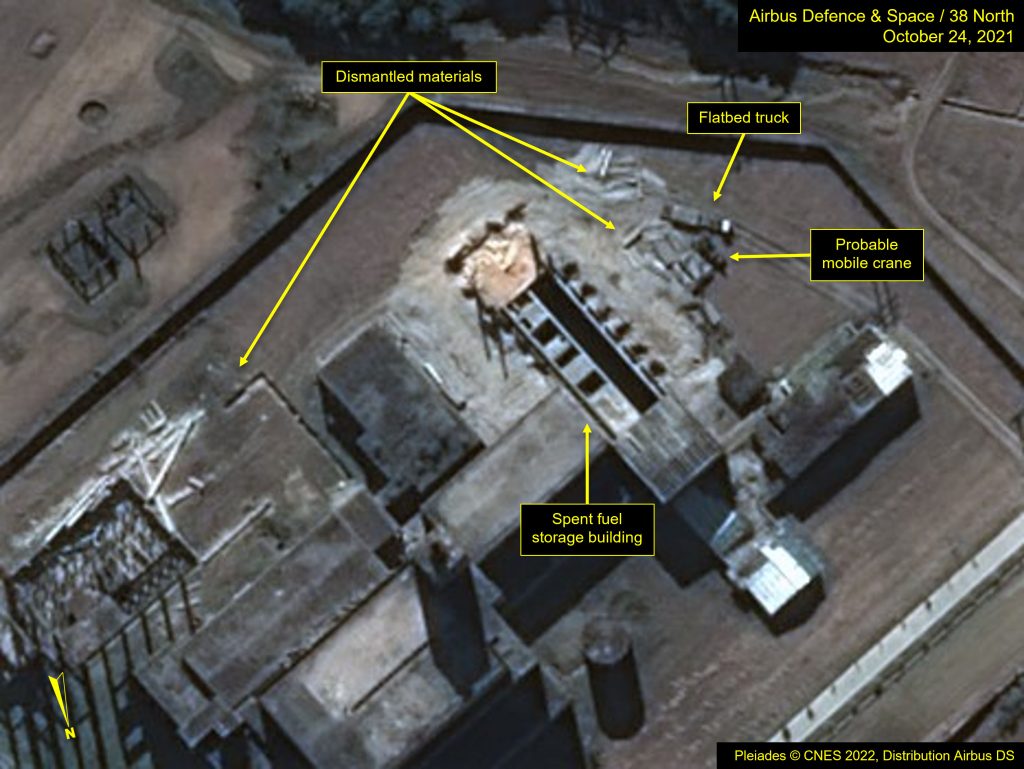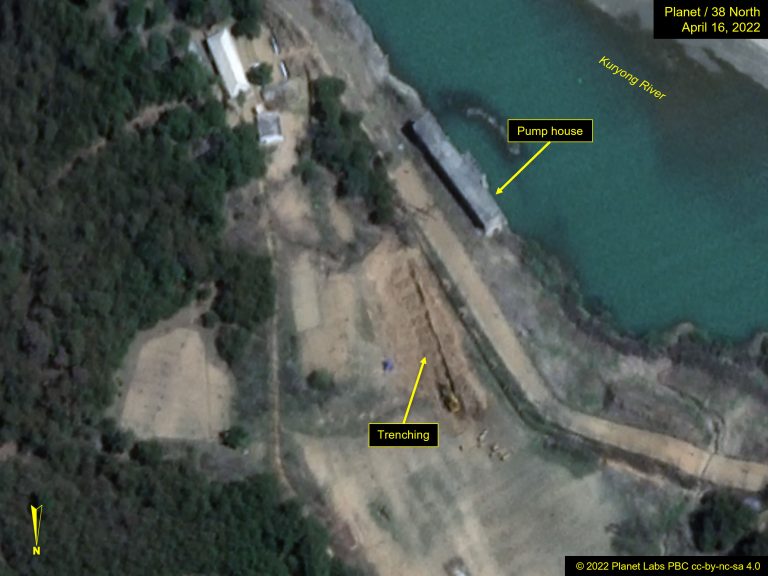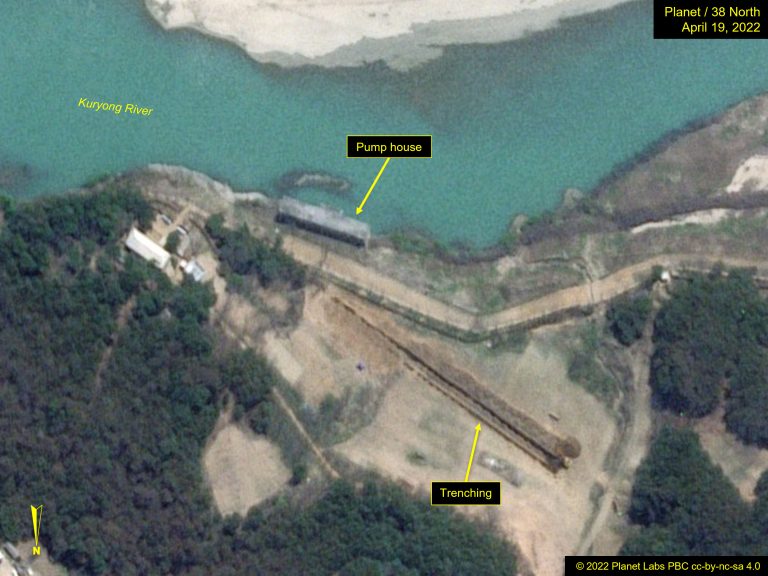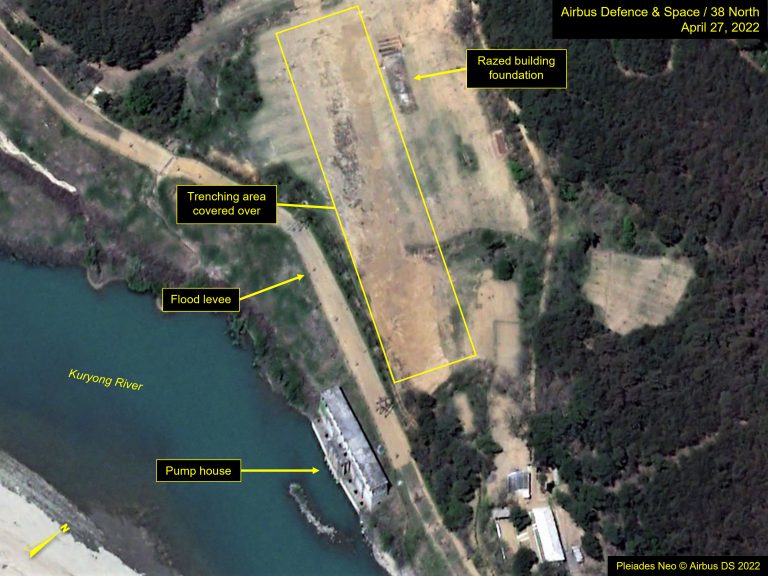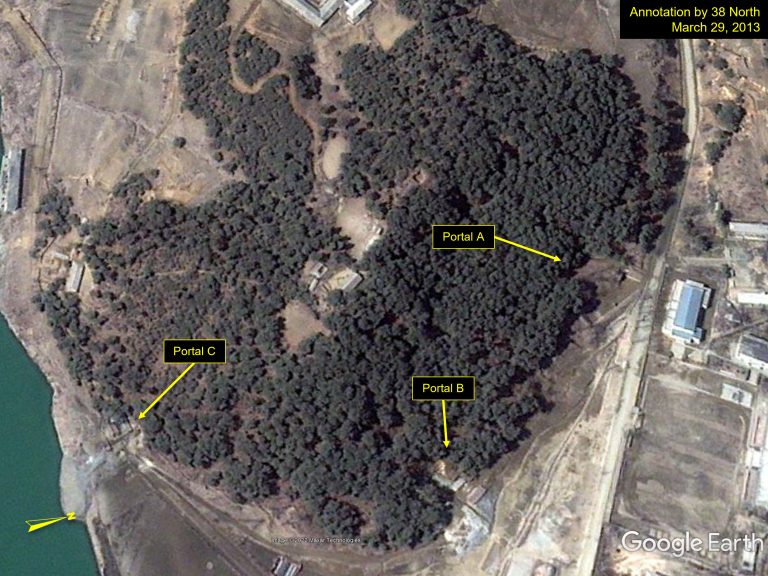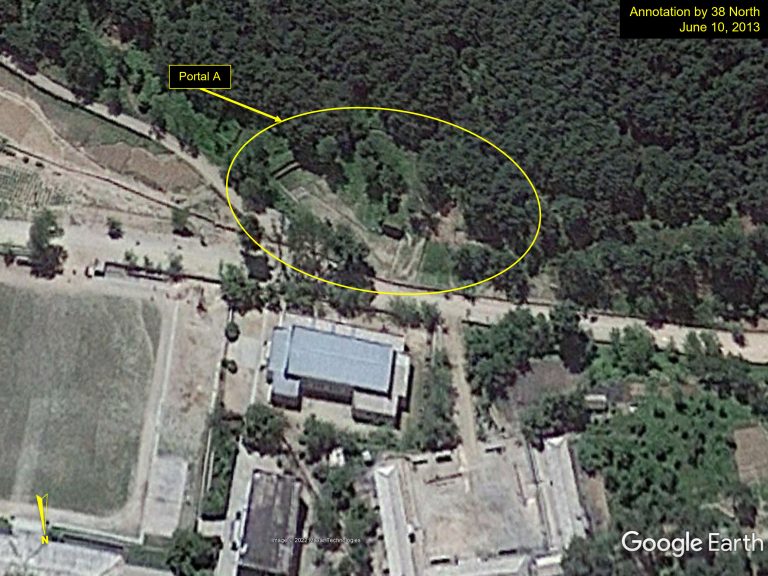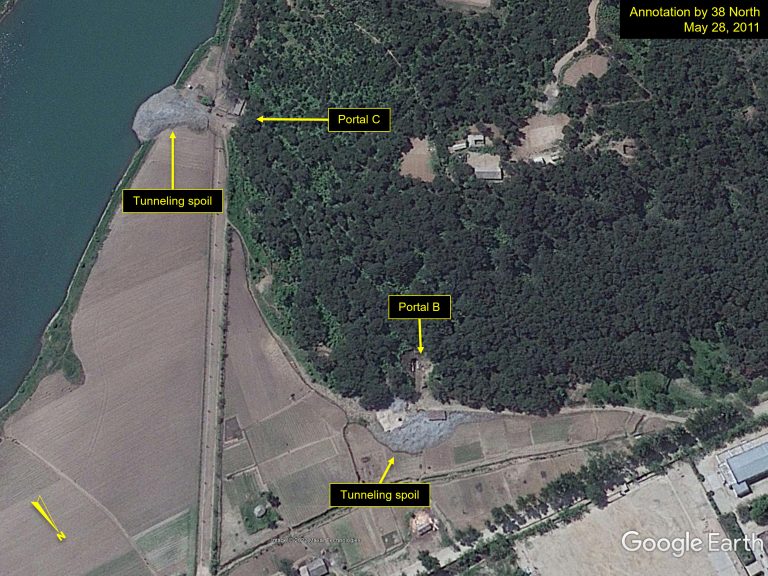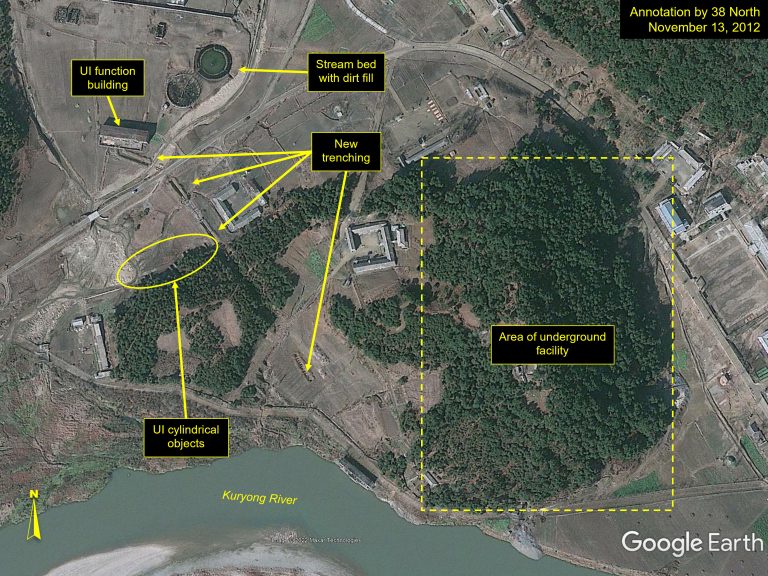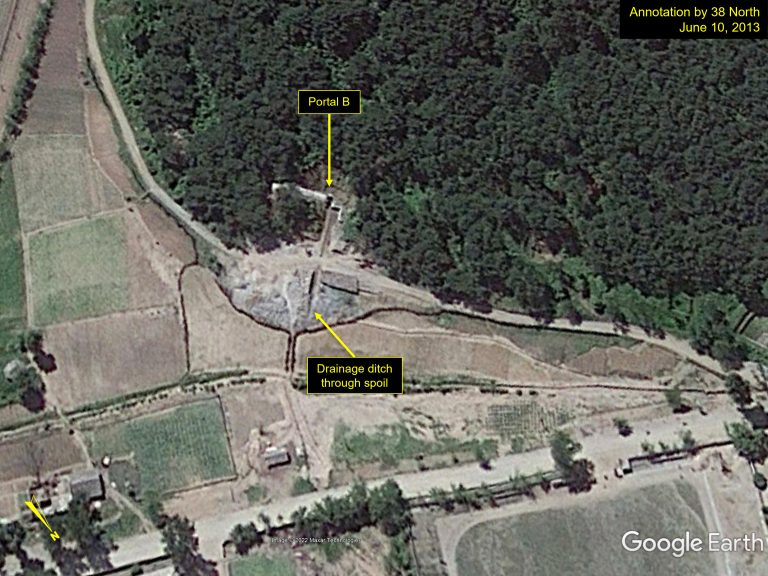Is North Korea Restarting Construction of the 50 MWe Reactor at Yongbyon? It’s Unlikely
Commercial satellite imagery of North Korea’s unfinished 50 MWe Reactor at the Yongbyon Nuclear Scientific Research Center suggests that the main reactor building is being scavenged for materials probably for use in other construction projects. Some trenching work was observed in April, initially reported by the Middlebury Institute of International Studies, near an old pump house on the Kuryong River originally intended to service this unfinished reactor project. But the purpose of this limited activity is unclear.
Construction of the 50 MWe Reactor began in the late 1980s and came to a halt in 1994 when the US and the Democratic People’s Republic of Korea (DPRK, or North Korea) signed the Agreed Framework, which was supposed to provide North Korea with light water reactors in lieu of graphite-moderated, gas-cooled reactors. Even when the Agreed Framework fell apart in 2002, construction did not resume. At that time, the project had already been stalled for eight years, and the previously installed reactor components had not been maintained.
Today, based on eyewitness accounts from 2007 through 2010, as well as commercial satellite imagery, the reactor vessel remains incomplete and badly corroded. The buildings are in a state of disrepair. Even North Korean officials referred to the reactor as “ruined concrete structures and iron scrap” in 2010.
Some activity around the site has been observed over the years, but no work has been done on the main reactor area. Moreover, building materials such as roofs have been partially dismantled in recent years, presumably as part of efforts to salvage metal for other industrial needs. The partial dismantlement of the spent fuel building started in 2021 might have been to repurpose the facility—perhaps to eventually store spent fuel for the Experimental Light Water Reactor—but no further work has been done on this building for nearly a year.
Given the current state of the reactor, the recent trenching work is unlikely to have indicated efforts to resume work on the 50 MWe Reactor. Instead, it may be related to operations at the nearby underground facility.
In addition to the trenching working in April, on May 28, a barge or boat was seen docked at the riverside pump house near where recent trenching activity occurred. This appears to be the first time a vessel has been observed in this location; it had departed by May 31. Its purpose is unclear, but may have been related to maintenance or repair of the pump house or also associated with operations at the underground facility.
Background
North Korea’s 5 MWe Gas-Graphite Plutonium Production Reactor (5 MWe Reactor) has been operational since 1986 and can produce up to six kilograms of plutonium per year, or enough fissile material for one nuclear weapon annually.
In the late 1980s, North Korea began construction of the 50 MWe Reactor, which would have had the capacity to produce approximately 55 kilograms of plutonium, or enough fissile material for an additional seven to 10 nuclear weapons annually. When the construction site was first inspected in 1992, the reactor vessel was in an early stage of construction. Other key components such as cooling piping or other necessary equipment such heat exchangers were still at the manufacturing workshops. North Korea had also started to manufacture the graphite blocks for the reactor but had only produced about half of what was needed. Manufacturing of the fuel rod cores had also started but still lacked the necessary cladding to complete production.
While it was originally expected to be operational by 1995, reactor construction was halted by the 1994 US-DPRK Agreed Framework, and it was never completed. Likewise, no reactor fuel was produced. Observers who visited the site noted cracks in the concrete, rusted out buildings and junk littering the grounds. North Korean assessments at the time were that it would be more cost effective to build a new reactor than try to salvage what had been built so far. Work did not resume when the agreement collapsed in 2002.
When the International Atomic Energy Agency (IAEA) returned to North Korea in the summer of 2007, it reported: “There has been no construction work at this installation since 2002. The Agency has made photographic records and has confirmed the status of the facility.” A site visit report by Dr. Siegfried Hecker in 2010 quoted the senior North Korean technical official leading the facility tour, introducing the reactor as: “In the early 1990s we built 50 and 200 MWe reactors (of gas-graphite design). Now they have become ruined concrete structures and iron scrap…”
Past Activity Around the 50 MWe Reactor
While no new construction on the 50 MWe Reactor has been reported by inspectors or observed in commercial satellite imagery, some activity around the reactor has not been unusual.
In 2003, the Institute for Strategic and International Studies (ISIS) documented that when operations resumed at Yongbyon, the temporary housing at the 50 MWe Reactor that had been erected for construction workers was dismantled.
In 2005, ISIS reported that the road around the reactor site had been resurfaced, and a possible new crane was on the grounds. However, there were no signs of large scale construction.
Between late October 2010 and early April 2011, the North Koreans removed a large tower crane that had been used to erect the 50 MWe Reactor’s reactor hall.
In 2014, imagery showed the road around the reactor had been paved but the crane seen near the road in 2005 remained apparently abandoned in place.
In 2016, a small single story building had been built in front of the reactor’s main entrance, and a circular area had been cleared next to it. Its purpose is unknown, but a placard had been placed just across the street from the new building were observed.
Between February and June 2018, an eight-by-six-meter hole appeared in the roof of the reactor building. A second circular structure was erected next to a small administrative or support building in December. The structure, approximately 4.5 meters in diameter, appears to be a water holding tank.
In 2019, new trenching was noted underneath the southeastern security wall along with new excavation near the reactor building. Additionally, the small single story building built in 2015 was razed in late October or early November.
In August 2020, a typhoon hit the region, causing flooding and wind damage at Yongbyon, including at the 50 MWe Reactor complex. In the following months, repairs to a road and bridge south of the reactor and the roofs of several buildings in and around the complex.
In February 2022, troops were seen in formation outside one of the buildings. Snow had been removed from that area of the complex and had melted off the roofs of two of the buildings, suggesting activity within.
Figure 1. Activity around the 50 MWe Reactor (2014-2020).
Spent Fuel Building Activity
Between June and August 2021, as previously reported by 38 North, the roof and walls of the spent fuel storage building were dismantled, revealing the storage ponds. During that process, the removed building materials appeared to have been salvaged, possibly for future use on site or elsewhere. In October, a flatbed truck was present and appeared to be hauling away the stacks of recovered material. By November 1, the materials were gone.
At the time, 38 North analysts suggested that because the water treatment area was not dismantled, it was possible the building was being repurposed rather than being fully torn down.
Imagery from April 27, 2022, however, shows the building remains uncovered. What appeared to be excavated footings for new pillars are still visible, but no further work appears to have been done since the roof was removed in 2021.
The partial dismantlement of the spent fuel storage building was not an isolated case around the 50 MWe Reactor complex. In July 2021, approximately half of the posts and girders from the framework of another building that was never completed were also taken down. Presumably, some of those materials were removed from the site, while others remain strewn on the ground nearby.
In February 2022, a number of roof sections had been removed from the south wing of the main building. A crane was observed working at the south end, and a flatbed truck was parked nearby, presumably to take the salvaged materials away. Imagery from May reveals the removal of more roof panels. Together, the cannibalization of these structures does not point to actions to resume construction of the 50 MWe Reactor.
Figure 2. Partial dismantlement of the spent fuel storage building in 2021.
Figure 3. Overview of activity from 2020-2022.
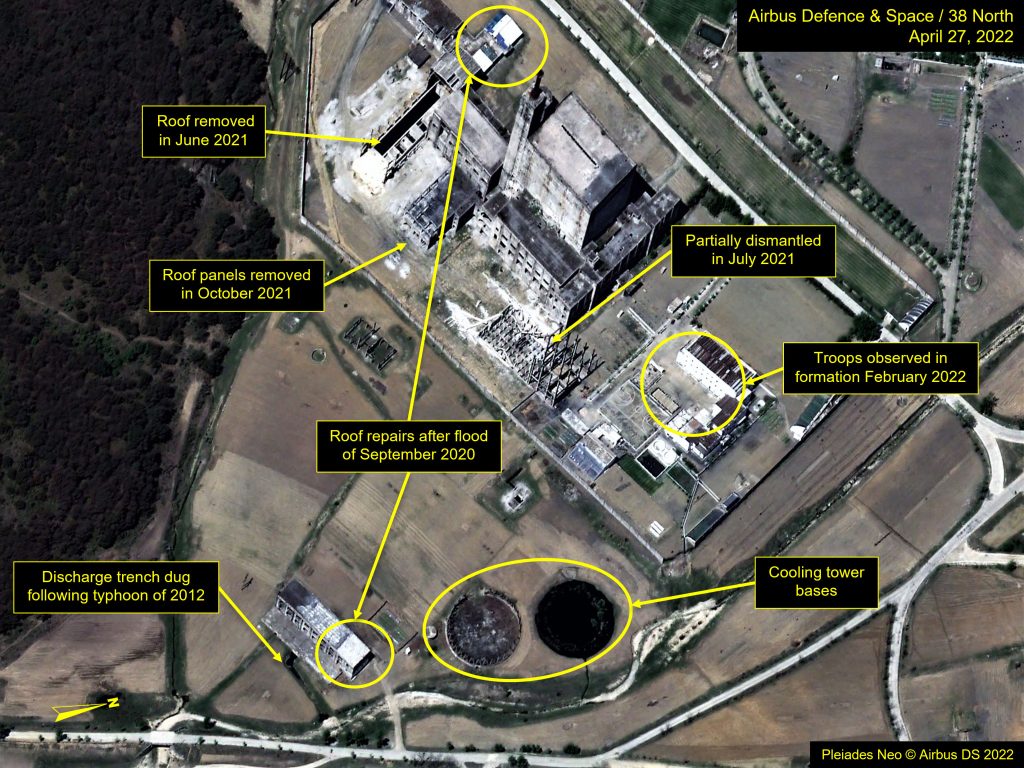
Recent Trenching Activity
In April 2022, as reported by Middlebury Institute, trenching for what appeared to be pipe work can be seen in a field near an old pump house on the Kuryong River. It began from a point just north of the pump house and extended to the west approximately 60 meters. On various dates, a few large-diameter, but short cylindrical objects were present near the trench where a power shovel was at work. These may have been pipe segments and it is unclear if they are being installed or removed.
By April 19, the trenching had crossed much of the field—a distance of around 140 meters—and by 27th, the trench had been covered over. But the purpose of this work remains unclear.
It had been thought that this large, riverside pump house, located just a half kilometer downstream from the 50 MWe reactor, was constructed to service the reactor. However, its role in the reactor complex is uncertain since construction began before frequent high resolution commercial satellite imagery was available. Thus, much of what is known comes from open-source accounts by site inspectors, defector reports, and forensic evidence gleaned from satellite imagery beginning in early 2000.
Given the body of evidence discussed earlier regarding the 50 MWe reactor’s condition and the dismantlement activity seen around the complex, it is unlikely this trenching is associated with efforts to finish the reactor. While this activity could indicate an effort to salvage pipes in that area for other purposes, it is more likely related to the large, underground facility located beneath the hill where this field is located.
Figure 4. Overview of area of trenching activity.
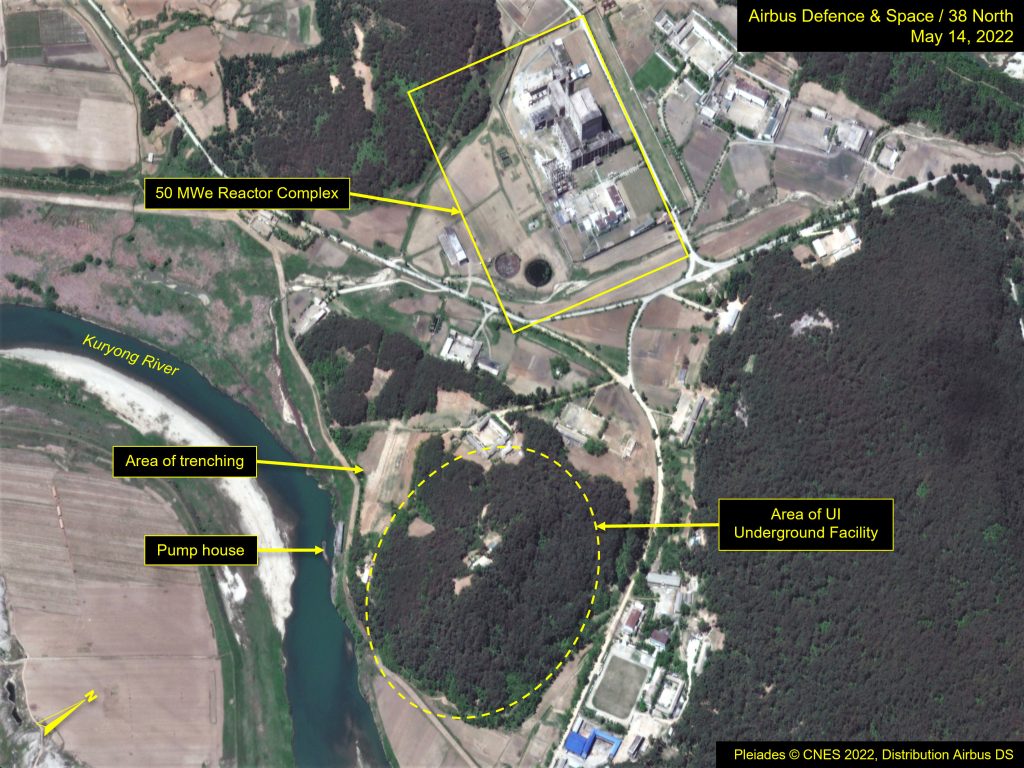
Figure 5. Trenching activity from April 16-27, 2022.
The Underground Facility
A 38 North article in 2019 by Frank Pabian profiled this underground facility. As documented in that report, initial tunnel excavation for this complex began between April 2005 and April 2006. By 2010, two additional entrances were excavated into the same hillside. All three entrances are connected by a service road and there is at least one utility or powerline connected to the third tunnel entrance. Expansion activities appear to have concluded by fall 2013. A year later, the spoil piles had been smoothed over and natural vegetation began to take hold. By 2019, the area was completely camouflaged with vegetation.
This underground facility demonstrates conditions similar to a “wet” cave, which requires water drainage and management to inhabit. For instance, drainage ditches were dug leading from the portals and across the spoil piles in the fall of 2012, following a typhoon that year, suggesting the importance of channeling storm waters in this area. Further drainage or repair of drainage systems for this facility may have been recently necessary ahead of this year’s rainy season.
Figure 6. Overview of the Underground Facility area.
Recent Trenching vs Prospective Path to the 50 MWe Reactor
The reactor’s original design called for the use of two cooling towers, akin to the original operational design for the 5 MWe Reactor with its single cooling tower. The twin towers for the 50 MWe reactor, however, never progressed beyond laying their foundations.
Imagery from March 2003 showed the likely path for the planned pipeline from the pump house to the 50 MWe. From the pump house at its eastern point, the path extends westward, crosses an open field, cuts through a tree covered hill, passes just south of a small support facility where a small, rectangular covered reservoir is located, and then crosses under a dirt road, through a stream, and terminates at the south side of a building whose purpose is unknown. None of that likely path has been recently disturbed. All recent activity has instead, been confined to the field near the old riverside pump house.
Figure 7. Likely path of the 50 MWe Reactor pipeline.
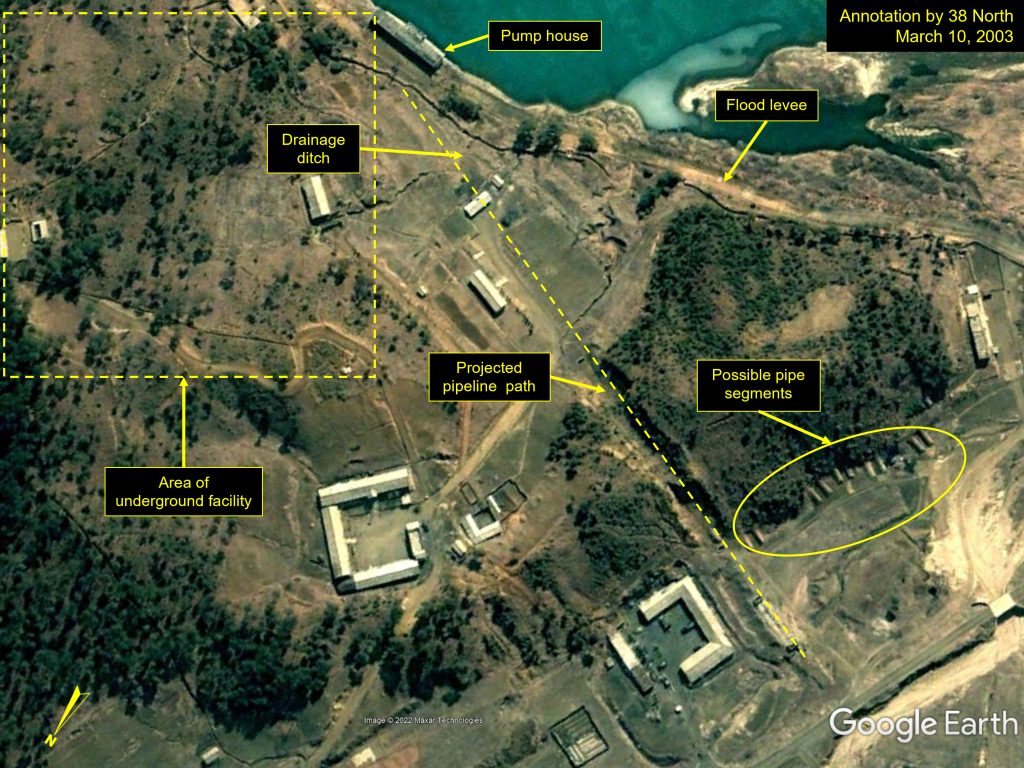
One possibility is that the recent trenching may be related to agriculture. Crops have flourished in the field where the trenching took place since 2010. But it appears excessive for field drainage alone. The numerous drainage ditches present, many of which begin at the top of the hill, are likely adequate to prevent flooding during the rainy season.
Rather, the presence of the underground facility beneath the field suggests a more likely purpose: the protection of that facility from seepage from the kind of heavy rains that are common in North Korean summers.
Recent Activity
Imagery from May 28, 2022 shows a barge or boat berthed near the riverside pump house. Its purpose was unclear, although it may be related to maintenance and repair of the pump house itself or associated with operations at the underground facility. The vessel had departed by May 31. While dredges have been observed near pump houses along the river before, this appears to the be the first time seeing a boat or barge in this location.
Figure 8. Probable barge or boat at the riverside pump house.
